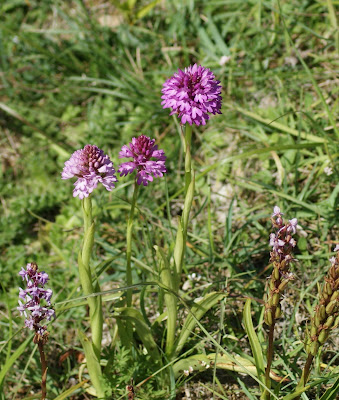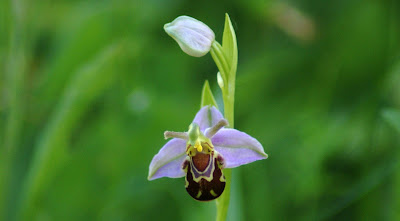
Violet Helleborine is not particularly uncommon, but this form - var. rosea - which contains no chlorophyll, is quite rare.

After lunch we entered the Pulpit Hill/Grangelands Reserve. This Red Kite flew right over our heads.

Our Musk Orchids in Bedfordshire are the most northerly population in the UK, but we haven't seen any flower-heads for the last couple of years. You have to get your eye in to spot them and there were just two here. Is that a tiny fly in the photo? The books says that the insects who get to pollinate these minute flowers have to be tiny themselves (up to 1 mm long!).

At Aston Clinton Rag Pits were were taken aback by the thousands of Fragrant Orchids, even though they were past their best now. Pyramidal Orchids were dotted about - 3 can be seen in the photo above. Other plants here included White Helleborine, Common Twayblade, and Broad-leaved Helleborine.

We'd just been saying how surprised we had been not to have seen a Bee Orchid all day when we came across this beauty!
It was getting late, now, so we moved on to one last Reserve.

This is the first Fly Orchid that I have seen. It's right at the end of its flowering season and this was the only flowering spike, so I was very fortunate. What an incredible plant it is - it even secretes sex pheromones to attract a particular species of male Digger Wasp to pollinate it....amazing!
Our full list of orchids for the day comprised:
Common Spotted Orchid; Fragrant Orchid; Pyramidal Orchid; Bee Orchid; Greater Butterfly Orchid; Musk Orchid; Common Twayblade; Fly Orchid; Violet Helleborine; Red Helleborine; White Helleborine; Broad-leaved Helleborine; Narrow-lipped Helleborine.
No comments:
Post a Comment